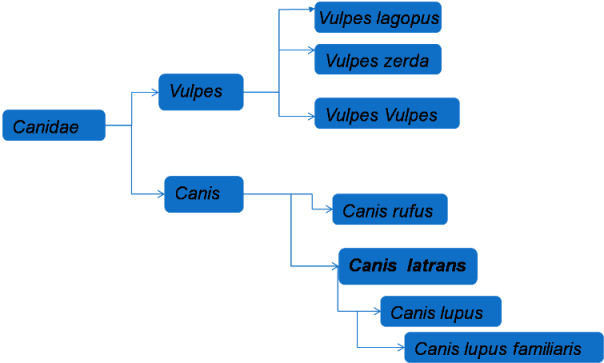
Classification - What's in a Name?
The English name is derived from the word “Coyotl” from the Aztecs, in whose tribe it played an important role in mythology. Several of their gods and many of their leaders had names containing some derivative of the word "coyotyl”. A few examples are:
The following is a chart showing the classification of Canis latrans, with a brief description of how it fits into each category:
|
Domain |
Eukarya |
cells within the organism
have a membrane-bound nucleus and multiple specialized
organelles |
|
Kingdom |
Animalia |
the organism is
multicellular, heterotrophic, and has no cell walls
present |
|
Phylum |
Chordata |
the organism is
bilaterally symmetrical, highly cephalized,
triploblastic, has a complete digestive tract, and has a
notochord, a dorsal nerve cord, pharyngeal pouches, an
endostyle, and a post-anal tail present at some point in
the life cycle |
|
Class |
Mammalia |
has hair, is
homeothermic, has sweat, sebaceous and mammary glands to
provide nourishment for offspring, has a jaw that
consists of a single bone, and has facial muscles and
lips present |
|
Order |
Carnivora |
Preys on other animals as
a primary source of nourishment |
|
Family |
Canidae |
Have five toes on the
forefeet and four toes on the hindfeet, non-retractile
claws, and often form packs with social hierarchy
systems |
|
Genus |
Canis |
A group that
includes coyotes, jackals, wolves, and domestic dogs |
|
Species |
Canis latrans |
a mid-sized canine that can live in a variety of habitats and is incredibly adaptive |
